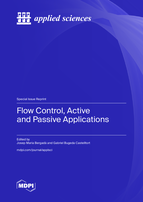Flow Control, Active and Passive Applications
A special issue of Applied Sciences (ISSN 2076-3417). This special issue belongs to the section "Energy Science and Technology".
Deadline for manuscript submissions: closed (31 December 2022) | Viewed by 26487
Special Issue Editors
Interests: active flow control; aerodynamics; compressible flow; fluid mechanics
Special Issues, Collections and Topics in MDPI journals
2. International Center for Numerical Methods in Engineering (CIMNE), 08034 Barcelona, Spain
Interests: shape optimization; robust design; active flow control
Special Issue Information
Dear Colleagues,
Boundary layer modulation has drastic effects on the forces acting to any bluff body, thereby allowing large energy savings and a considerable improvement of the body efficiency. One of the latest techniques to modify the boundary layer is Active Flow Control (AFC), which mainly consists of injecting/sucking flow in particular locations where the boundary layer separation is about to occur with the aim of delaying the separation of it.
Active Flow Control (AFC) applications have just started to gain momentum and it seems that the scope of its application is likely to increase rapidly in the near future. In this Special Issue, we plan to cover all possible aspects of AFC as well as Passive Flow Control (PFC), from basic actuators configurations and performance to any sort of application on airplane airfoils, windmills, road vehicles or turbine aerodynamics, among others. Special attention will be paid to the optimization of AFC parameters in any application. Both numerical and experimental research are equally welcome in this Special Issue.
Researchers are encouraged to submit high quality and novel papers which, after being peer reviewed by specialists in the field, shall be published.
Dr. Josep Maria Bergadà
Prof. Dr. Gabriel Bugeda Castelltort
Guest Editors
Manuscript Submission Information
Manuscripts should be submitted online at www.mdpi.com by registering and logging in to this website. Once you are registered, click here to go to the submission form. Manuscripts can be submitted until the deadline. All submissions that pass pre-check are peer-reviewed. Accepted papers will be published continuously in the journal (as soon as accepted) and will be listed together on the special issue website. Research articles, review articles as well as short communications are invited. For planned papers, a title and short abstract (about 100 words) can be sent to the Editorial Office for announcement on this website.
Submitted manuscripts should not have been published previously, nor be under consideration for publication elsewhere (except conference proceedings papers). All manuscripts are thoroughly refereed through a single-blind peer-review process. A guide for authors and other relevant information for submission of manuscripts is available on the Instructions for Authors page. Applied Sciences is an international peer-reviewed open access semimonthly journal published by MDPI.
Please visit the Instructions for Authors page before submitting a manuscript. The Article Processing Charge (APC) for publication in this open access journal is 2400 CHF (Swiss Francs). Submitted papers should be well formatted and use good English. Authors may use MDPI's English editing service prior to publication or during author revisions.
Keywords
- active flow control
- passive flow control
- aerodynamics
- optimization
- turbulent boundary layer flow control
- drag reduction, skin–friction drag reduction
- plasma actuators
- jet actuators
- moving walls






